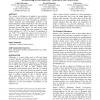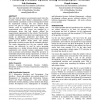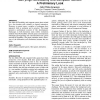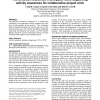NORDICHI
2004
ACM
14 years 8 months ago
2004
ACM
The concept of affordance as it applies to user interface design is widely used and accepted; possibly overused. This paper explores one of the constraints on affordance: culture....
NORDICHI
2004
ACM
14 years 8 months ago
2004
ACM
This case study examines a procurement project where the Swedish National Labor Market Administration (AMV) hired usability consultants in order to redesign their website for empl...
NORDICHI
2004
ACM
14 years 8 months ago
2004
ACM
It is critical to the success of a system that appropriate and representative users are involved in the development work. However, the process of identifying and selecting users h...
NORDICHI
2004
ACM
14 years 8 months ago
2004
ACM
The fields HCI/usability and computer games have existed for a few decades with virtually no mutual interaction. However, in recent years, a number of exchanges have appeared, bot...
NORDICHI
2004
ACM
14 years 8 months ago
2004
ACM
NORDICHI
2004
ACM
14 years 8 months ago
2004
ACM
This paper describes a new digital user study tool called Mobile Probes. Mobile Probes arose from a need to develop contextual and dynamic self-documenting tools for studying peop...
NORDICHI
2004
ACM
14 years 8 months ago
2004
ACM
This talk discusses how to strike a good balance between making the user an active co-constructor of system functionality versus making a too strong, interpretative design that do...
NORDICHI
2004
ACM
14 years 8 months ago
2004
ACM
Systems development is replete with projects that represent substantial resource investments but result in systems that fail to meet users’ needs. Evidence-based development is ...
NORDICHI
2004
ACM
14 years 8 months ago
2004
ACM
Mission Queen Maud Land (MQML) is a collaborative virtual environment that was developed to explore new ways to stimulate secondary school pupils to collaborate in grasping comple...
NORDICHI
2004
ACM
14 years 8 months ago
2004
ACM
The BRIDGE awareness workspace is a synchronous collaborative tool supporting activity awareness for longterm (weeks/months) group projects. This workspace features integrated tim...




